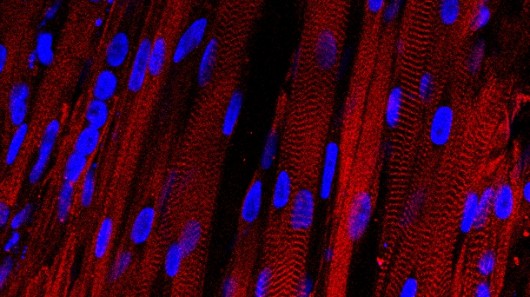
Researchers working at Duke University’s Pratt School of Engineering claim to have produced a laboratory first by having grown human muscle tissue that contracts and reacts to stimuli. Electrical pulses, biochemical signals and pharmaceuticals have all been used to produce reactions in the tissue that show it behaves in the same way that natural human muscles does. As a result, laboratory grown tissue may soon provide researchers with the ability to study diseases and assess drugs without invasive procedures on human subjects.
In a study headed by Nenad Bursac, associate professor of biomedical engineering at Duke University, and Lauran Madden, a postdoctoral researcher in Bursac’s laboratory, the team began by using a sample of human cells that had already been grown beyond the stem cell stage, but had not yet formed into muscle tissue. These "myogenic precursors" (that is, cells that will become muscle tissue) were then stretched by the researchers over a supportive scaffolding designed to promote their growth in 3D and to increase their area to more 1,000 times their original size.
Molded from PDMS (silicone), the entire structure was filled with a growth medium that allowed the cells to develop while the structure itself helped to form aligned and functioning muscle fibers. As a result, the team was able to grow around 5 grams of muscle tissue for every 50 mg of donor tissue – a hundred-fold increase in mass.
"We have a lot of experience making bioartifical muscles from animal cells in the laboratory, and it still took us a year of adjusting variables like cell and gel density and optimizing the culture matrix and media to make this work with human muscle cells," said Madden.
To ascertain how closely it replicated muscle tissue naturally occurring within a human body, Madden peppered the newly-formed muscle tissue with an array of tests. As a result, when electrical stimuli were applied, Madden observed that the muscles strongly contracted in response. As the first human muscle grown in a laboratory to react in this way, further tests also showed that along the entire length of the new tissue pathways for nerves to activate the muscle were also complete and functioning.
The team then turned its attention to finding out if its created muscle could be used as a substitute for human-produced muscle in medical tests. Using a variety of drugs, including cholesterol-lowering statins and a performance-enhancing drug Clenbuterol, a drug notorious for use by some athletes, the team aimed to ascertain the reactions to these drugs in relation to the way naturally-grown muscle reacts.
As it turned out, the effects of these drugs matched the effects documented in human patients. The statins showed a dose-dependent response and the Clenbuterol showed a slim, but beneficial, window for increased contraction. The lab-grown muscle had given a truly human response.
"The beauty of this work is that it can serve as a test bed for clinical trials in a dish. We are working to test drugs’ efficacy and safety without jeopardizing a patient’s health and also to reproduce the functional and biochemical signals of diseases – especially rare ones and those that make taking muscle biopsies difficult," said Bursac.
"One of our goals is to use this method to provide personalized medicine to patients," Bursac concluded. "We can take a biopsy from each patient, grow many new muscles to use as test samples and experiment to see which drugs would work best for each person."

 Previous page
Previous page Back to top
Back to top







